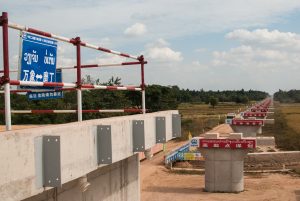By James Guild

Others have compared it to a 21st century Marshall Plan, with China trying to beat geostrategic rivals like Japan and the United States in shaping the physical, financial and political environment of key regions. In doing so they are also creating overseas demand for Chinese technology, investment and labor which is arguably a productive way for a country that runs big surpluses to make use of its reserves and idle assets while bolstering its strategic muscle. The truth, as is often the case, probably lies somewhere in the middle.
As Shahar Hameiri writes in the Lowy Institute’s Interpreter, “Never attribute to malice what can be explained by incompetence.” There is certainly merit to the strategic logic of underwriting infrastructure development in fast-growing or geographically important countries. But sometimes geostrategic ambitions can get ahead of practical considerations on the ground, and China’s experience with building high-speed railways in Southeast Asia certainly underscores this.
Announced in 2015, a 414 kilometer high-speed rail line linking the southern Chinese province of Yunnan with the Laotian capital of Vientiane is now about 90 percent completed; the track is being laid, and the line is expected to be operational some time in 2022. It is part of a grander vision to link Yunnan to Singapore, creating an artery through Southeast Asia’s booming economies and injecting life into China’s landlocked southern provinces. At the moment, however, that vision remains illusory as planned legs in Thailand and Malaysia have stalled. The line will not go beyond Vientiane any time soon.
But at a cost of $6 billion, this is a big deal in Laos, a country with a GDP of $19.2 billion in 2019. In the process of constructing this line, Laos has incurred an estimated $1.5 billion in external debt to China, and is now struggling to maintain sufficient forex reserves to avoid a balance of payment crisis. This is even more striking when considering that in 2012, only 17 percent of Laos’ roads were paved. The takeaway here may be that if the government was going to run up big external debts to improve transportation infrastructure, it might have been wiser to start with more modest goals before settling on a high-speed railway worth one-third of the country’s GDP.
The Jakarta-Bandung High Speed Rail project in Indonesia offers similar lessons. In 2015, Indonesia dramatically chose China over Japan for the construction a $5.5 billion, 150 kilometer high-speed rail line connecting Jakarta to Bandung, the provincial capital of West Java. It was expected the project would be finished within three years, and the deal was sweetened when China did not ask for any explicit guarantees from the Indonesian state.
The project has been plagued with land acquisition delays and, as of early 2020, was less than 50 percent complete, while the West Bandung Regent blamed construction for causing severe flooding earlier this year. One day trains will run on this line, cutting travel time between the two cities to about an hour. But when traffic is light you can already drive from Jakarta to Bandung in a little over two hours, which begs the question of whether all of this was worth it in the first place.
In the end, that seems to be the question that hangs over these projects. An exuberant China running big surpluses and with a loose strategic vision has dangled very sweet terms in front of countries where it wanted to bulk up its presence and stimulate demand for its goods, capital and labor. In the process, many BRI projects got out ahead of very basic practical considerations like whether the economic benefit justified the cost, or whether recipient countries could implement and finance them sustainably, or whether the land could even be acquired. These concerns were shoved aside, and governments eager for FDI and flashy infrastructure projects helped support the vision while worrying about the details later.
To paraphrase a line from Jurassic Park, rather than deliberately trapping countries in a cycle of bad debt, it seems more likely that all sides rushed to undertake projects because they could, without stopping to think if they should. And what is left is the outline of a grand vision that didn’t quite solidify, a series of high-speed railways that don’t cover much ground but do echo both the ambitions and the limits of China’s strategic aims in the region.
No comments:
Post a Comment